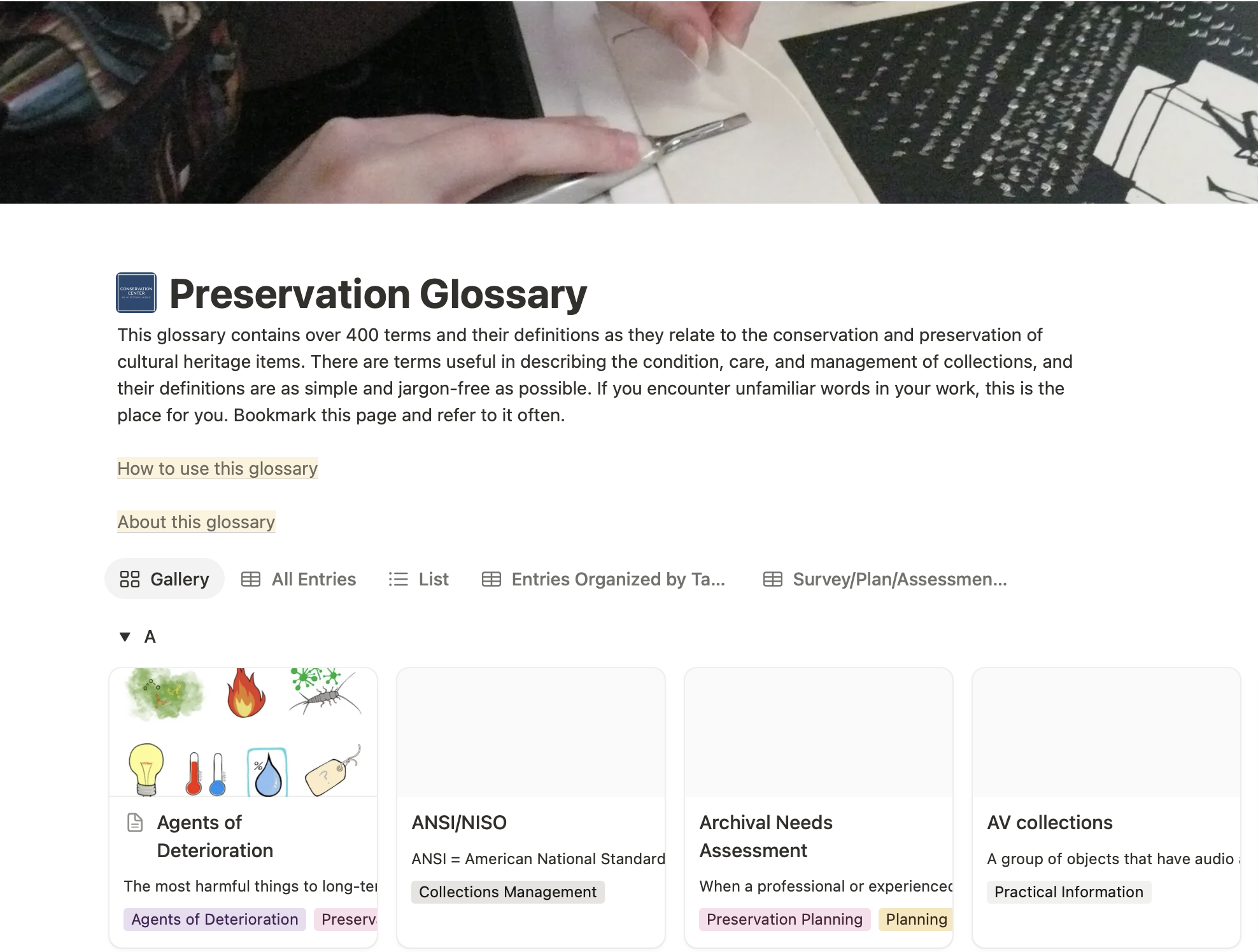
Whether you're writing a preservation plan, reviewing a conservation treatment proposal, or attending a training workshop, you’ve probably encountered unfamiliar or highly specialized terminology. That’s why we’re excited to share a new resource from the Conservation Center for Art & Historic Artifacts (CCAHA): a free, searchable Preservation Glossary featuring nearly 400 simplified, image-rich terms related to collections care, conservation, and preservation.
Funded by the National Endowment for the Humanities, the glossary was designed to make preservation language more accessible for those working in libraries, archives, museums, and other cultural heritage organizations — especially smaller institutions or those without full-time preservation staff. As CCAHA Preservation Specialist Katie Lowe explains, “We based a lot of the new content on the desire to demystify those things that feel like ‘assumed knowledge’ in the museum, archive, and preservation industries.”
With simple definitions, clear formatting, and image support, the glossary helps make sense of technical vocabulary in categories such as:
- Preventive care and damage types
- Preservation planning and emergency preparedness
- Digital preservation
- Conservation treatments
- Materials and storage
The glossary’s strength lies not only in the breadth of its content but also in its thoughtful presentation. Definitions are written at an accessible reading level thanks to CCAHA’s collaboration with writer and reading specialist Lori Litchman. And because it’s a living resource, new terms and updated definitions will continue to be added over time.
At DHPSNY, we frequently work with institutions that are new to preservation planning or just beginning to assess their collections needs. Having a reliable reference tool like this glossary can build confidence, promote learning, and empower more people to participate in collections care.
Here are three practical ways to make the most of this new tool in your day-to-day work:
1. Get Clear on Preservation Terms in Reports and Plans
Reading through a preservation assessment, HVAC report, or emergency plan draft and hit a word like "off-gassing" or "inherent vice"? Type it into the Preservation Glossary search bar to access a plain-language definition, related terms, and supporting images when available.
Try it out: Search for “buffering” to better understand pH-buffered enclosures when selecting storage materials.
2. Use It as a Training Tool for Staff, Interns, and Volunteers
Training a new collections assistant? Onboarding a summer intern or volunteer? The glossary is a great tool for reinforcing key concepts in preventive care, labeling, and handling. Bonus tip: Use the glossary as a vocabulary resource during staff development days or to supplement internal handling and storage guidelines.
Try it out: Search for “mechanical damage” to explore common risks during handling and transport.
3. Build Your Institutional Vocabulary
Preservation and conservation terms can vary depending on context or discipline. The glossary helps you build a more consistent internal language for describing collections needs, something that’s especially helpful when applying for grants, writing policies, or preparing board or administration updates.
Try it out: Search for “preservation priorities” or “condition assessment” when drafting a collections care summary for a grant narrative.
Ready to explore the glossary? You can access the full resource at CCAHA.org/PreservationGlossary. Check out CCAHA’s How to Use the Glossary for quick tips on search filters, definitions, and how to suggest a new term.
We encourage our DHPSNY community to share it with colleagues, volunteers, board members, and students — anyone who might benefit from clearer, more inclusive access to the language of preservation.
Curious to see the glossary in action? Check out CCAHA’s recent webinar, Say What? Demystifying Preservation And Conservation Terms With CCAHA’s New Glossary, for an overview of the resource and tips for using it in your work.